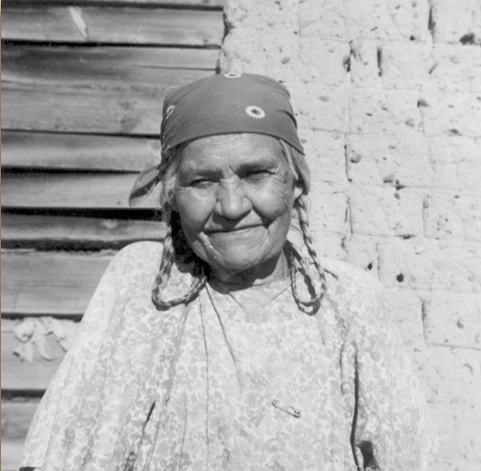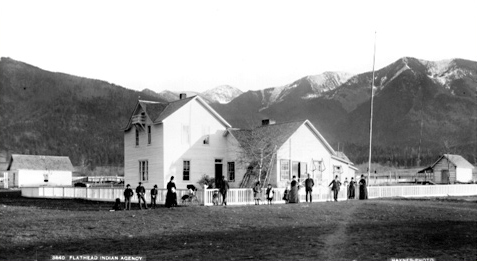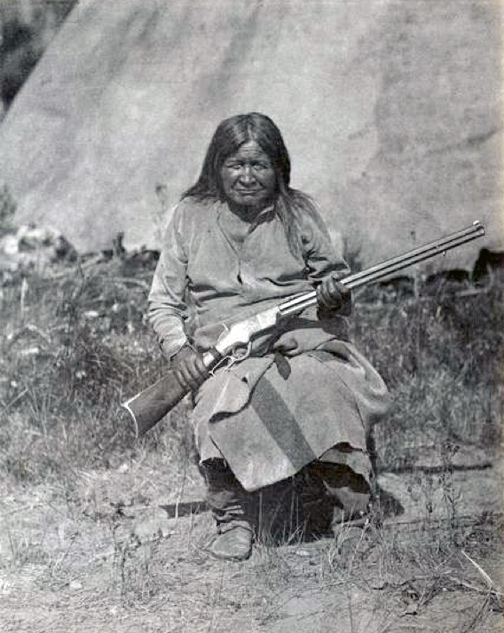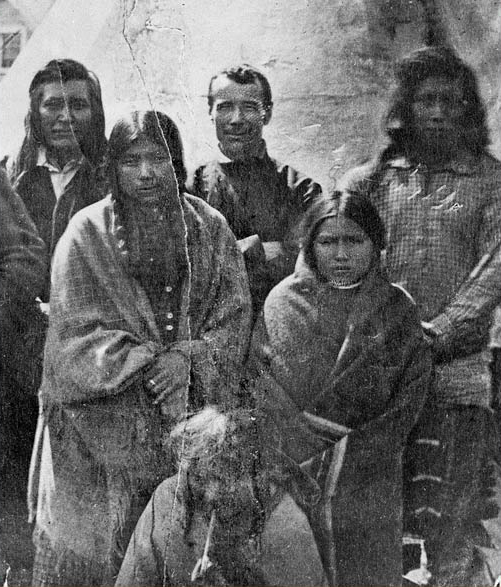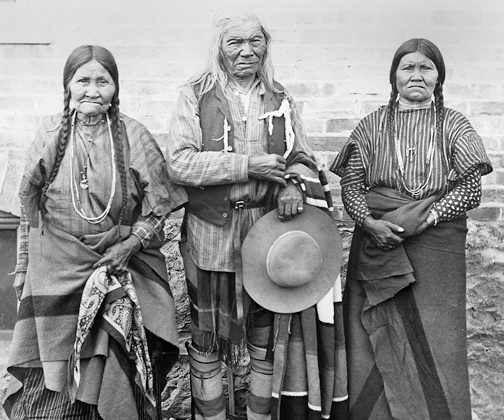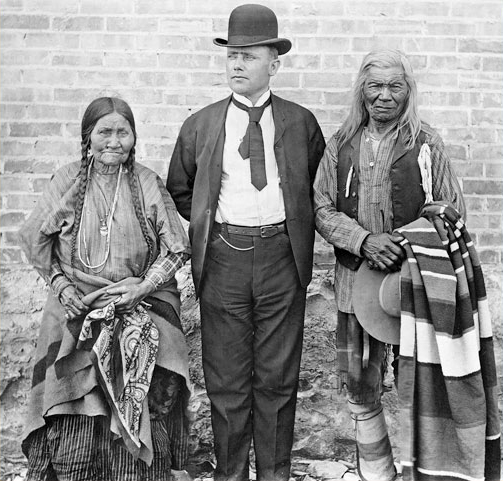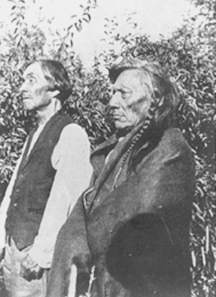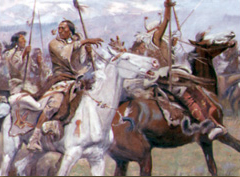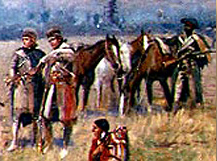“Lewis and Clark Meeting the Flatheads in Ross Hole, 4 September 1805”
Reproduced by permission of the Montana Historical Society.
As told by Sergeant Ordway
Sergeant Ordway filled in more details of the Lewis and Clark Expedition’s visit with the Salish on 5 September 1805:
our officers took down Some of their language found it verry troublesome Speaking to them as all they Say to them has to go through Six languages, and hard to make them understand.
The captains’ questions were translated into French by Drouillard or Labiche, directed to Charbonneau, who conveyed them to Sacagawea in Hidatsa, who rephrased them in her native language to a young Shoshone who was with the tribe and could speak Salishan—”a gugling kind of languaje,” noticed Clark, “Spoken much thro the Throught.” Answers followed the same route in reverse. And what did they speak of?
The Americans:
we informed them who we were, where we Came from, where bound and for what purpose &c. &c. and requsted to purchase & exchange a few horses with them, in the Course of the day I purchased 11 horses & exchanged 7 . . . . these people possess ellegant horses.
The Salish offered encouraging words: “They tell us,” wrote Private Joseph Whitehouse:
that we can go in 6 days to where white traders come and that they had Seen bearded men who came a river to the North of us 6 days march but we have 4 mountains to cross before we come on that River.
At two o’clock on the afternoon of the 6th, the Salish set out to meet their friends, the Shoshones, at the Three Forks of the Missouri, to hunt buffalo together. The Americans headed for the Columbia River via the Indian “road” over today’s Lolo Pass.
As to those “4 mountains” and that “6 days march”: Was it that the intricate chain of communication had broken down, or that the Indians were merely describing familiar topography in concepts that were foreign to the Americans? More than likely it was the latter. In either case, the expedition was to spend the next 15 days walking down the Bitterroot Valley and climbing over the Bitterroot Range—”those tremendious mountanes,” Clark later called them—until they met some Nez Perce Indians on 20 September 1805.
As told by Agnes
In 1899 Father D’Aste, a Jesuit priest at St. Ignatius Mission on the Flathead Reservation, was told the following story by “a reliable old Indian” who had heard it from Agnes, the widow of Chief Victor. Victor, whose Indian name was Plenty-of-Horses, was born in 1790, and died during a summer buffalo hunt in 1870. He was the father of Charlo, or Small Grizzly Bear Claw, who succeeded him as head chief of the Salish. Three Eagles, or Tcleskaimi, was the leader of the Salish people when they met the Lewis and Clark party. As told by Agnes, Chief Victor’s widow:
One time when the Flatheads [Salish] were camping at Ross Hole, Chief Three Eagles left the camp to do his own scouting. He feared that some enemy Indians might be sneaking near the camp, intending to steal horses. At a distance he saw a party of about twenty men traveling toward his camp. Except for two chiefs riding ahead, each man was leading two pack horses. Chief Three Eagles was puzzled by the appearance of the strangers, for never before had he seen men not wearing blankets. Perhaps they have been robbed, he thought.
Returning to his people, he told them about the strange beings. He gave orders that all the horses should be driven in near camp and watched. Then he went back toward the party, hid himself in the forest, and watched them approach.
He saw that they were traveling slowly, without any suspicious behavior. The two leaders would ride ahead, seeming to survey the country, and then would go back and consult with their men.
“They must be two chiefs,” Three Eagles thought. “But what are they after? And why does one of their men have a black face? Who can he be?”
The Chief puzzled about the black man. Among his own people it was the custom to have a war dance if, on a buffalo hunt, they should see any sign of their enemies hiding around. For this dance, the warriors painted themselves—some with red, others with yellow, others with black. While dancing, they would encourage each other to fight bravely. This black man, thought Chief Three Eagles, must have painted his face black as a sign of war. The party must have fought with their enemies and have escaped, losing only their blankets.
Once more the chief returned to his camp and reported to his people.
“They are traveling in our direction,” he said. “Let us keep quiet and wait for them. They seem to have no intentions of fighting us or of harming us.”
So he and his people watched and waited. The strangers approached slowly, still showing no hostile intentions. When they came near the camp, the two leaders got off their horses and walked toward the people, making signs of friendship. They shook hands with Chief Three Eagles. Then all the Indian men shook hands with all the white men.
“Bring the best buffalo skins,” said the chief, “one for each man to sit on. Bring the best buffalo robes, and put them over the men’s shoulders.”
The two leaders saw that the Indians were smoking a strange plant. They asked for some and filled their pipes. But they did not like it. “It is no good,” they said.
Cutting some of their own tobacco, they asked the Indians to fill their pipes with it. But the Indians did not like it. It made all of them cough, and everybody laughed. Then the two leaders, making signs, asked for some kinnikinnick [bearberry]. They mixed the leaves with their own tobacco and gave the mixture to the Indians. The Indians liked it. So the people smoked together.
Seeing that everybody was friendly, the white men decided to camp there near the Indians. As they unpacked their horses, they explained with signs that they had blankets in their packs, used only for sleeping. So they gave back the robes.
The white men were very strong. Some of them carried on their shoulders very large logs to use for their campfires.
Our people and the white men continued to be friendly. On the third day they started off. We showed them how to get to the Lolo fork trail, which is the best way to get to the Nez Perce country on the west side of the mountains.[1]Ella E. Clark, Indian Legends from the Northern Rockies (Norman: Oklahoma University Press, 1966), 129-31. Used by permission.[2]The “Lolo fork trail” was not known by that name until around 1850.
As Told by Sophie Moiese
Sophie Moiese, with the aid of interpreter Louis Pierre, told this story:
When the dried meat was brought to the men, they just looked at it and put it back. It was really good to eat, but they seemed to think it was bark or wood. Also, they didn’t know that camas roots are good to eat. . . . Chief Three Eagles told his people that they must not harm the strangers in any way. Since then, no one has ever heard of the Salish tribe and whites getting into battle. During the Nez Perce War, the Nez Perces went through the Bitterroot Valley, but the Salish people stood by the whites at Fort Missoula. They would have fought their own Indian friends to keep them from harming the white people with whom Governor Stevens negotiated the reservation treaty of 1855.”[3]Ella E. Clark, Indian Legends from the Northern Rockies (Norman: Oklahoma University Press, 1966), p. 133. Used by permission.
As Told by Oshanee
Agent Peter Ronan’s home
Village of St. Ignatius, in the Mission Valley of Northwestern Montana
Photo by F. Jay Haynes, courtesy of the Montana Historical Society. F. Jay Haines collection. H-2007.
The mountains beyond are part of the Mission Range.
Peter Ronan was the U.S. Government’s representative, or Indian agent, on the Flathead (then called the Jocko) Reservation in northwestern Montana from 1877 to 1893. Most agents were political appointees, often unqualified as managers, and lacking appreciation for Indian beliefs and traditions. Ronan was an exception. He was patient, humble, and sensitive to the plight of the Salish, the Kootenais, and the Pend d’Oreilles. He tried very hard to uphold their rights in the face of overwhelming pressures from white settlers, entrepreneurs, and his own Federal government.
Peter Ronan’s History of the Flathead Indians, Their Wars and Hunts, 1813-1890, is a detailed and sensitive record of those peoples’ lives during their long transition from independent, sovereign nations in the era of Lewis and Clark, to a condition of total dependence upon a duplicitous and overbearing EuroAmerican culture.
Here, he recounts a story of the meeting of the Salish people with the Corps of Discovery, at Ross Hole, on 4–5 September 1805 after the Corps’ descent from the Bitterroot Divide. Oshanee’s story:
The new state of Montana [admitted in 1889], as well as the United States government, should not forget that they owe a debt of gratitude to the Flathead Indians for the friendly welcome extended to the early explorers and pioneers of this country, which is attested to be Lewis and Clarke [sic] in their official reports to President Jefferson and published so widely both in America and Europe. Captains Clarke and Lewis, with their followers . . . were the first white men the Flathead Indians ever beheld.
At the date of this writing, May 1890, there still lives at S. Ignatius mission, on the Flathead reservation, an old Indian woman named Ochanee[4]Spelled in Oshanee by Salish-Pend d’Oreillle Culture Committee, et. al., The Salish People and the Lewis and Clark Expedition (Lincoln, University of Nebraska Press, 2005), 107., who distinctly remembers, and relates in the Indian language the advent of those two great captains, with their followers, into the Flathead camp in the Bitter Root valley, and the great astonishment it created among the Indians.
The explorers crossed over the Big Hole Mountains and arrived at the Flathead camp in the Bitter Root valley in the year 1804 [1805]. Ochanee claims to have been about 13 years of age at that date. She is a lively old woman, and still has all of her mental faculties, and can describe camps, scenes and events which are vividly portrayed in the published reports of Lewis and Clark descriptive of the Flathead and Nez Perce Indians, who were then hunting and camping together.
During the stay of the explorers in the Flathead camp Captain Clarke took unto himself a Flathead woman. One son was the result of this union, and he was baptised after the missionaries came to Bitter Root valley [in 1850] and named Peter Clarke. This halfbreed lived to a ripe age, and was well known to many of Montana’s early settlers. He died about six years ago [c. 1884] and left a son, who was christened at St. Mary’s Mission< to the name of Zachariah, and pronounced Sacalee by the Indians. The latter has a son three years of age, whom it is claimed by the Indians, in direct descent, to be the great grandson of the renowned Captain Clarke.[5]Peter Ronan, History of the Flathead Indians, Their Wars and Hunts, 1813-1890 (1890, reprint, Minneapolis: Ross & Haines, 1965), 44.
Clark’s Offspring?
As striking as this account is, it is important to understand that there is no evidence that either of the officers, or any other member of the Corps of Discovery, was ever guilty of rape. On the contrary, there were many instances of native men offering their daughters, even their wives, to their white visitors for consensual sex, without any hint of salacity or moral turpitude but rather in the expectation of infusing the tribe with the blood of power and strength. Ochanee’s statement that Captain Clark “took unto himself” a Flathead woman was a common Biblical euphemism for “slept with” or “had sex with.” Furthermore, we are told that on more than a few occasions the women as well as their male guardians were genuinely offended, even highly insulted when the captains declined the offers, which according to the journals they did without exception. At the same time, the captains frequently, if tacitly, allowed the enlisted men to accept those offers at will, even at the risk of contracting sexually transmitted diseases.
Thus it is conceivable that all reports of Lewis and Clark themselves fathering offspring among the natives were merely selfish or political gestures aimed to gain prestige within the tribe or even beyond, when the sire in reality was a common soldier of low standing in white culture. On the other hand, the endurance of some claims throughout two or more successive generations, even without corroboration from Lewis or Clark, seem to lend the story the weight of truth.
Tzi-kal-tza
This photo has been credited to William Henry Jackson, the pioneer artist and photographer. Courtesy Wisconsin Historical Society, Image ID 6541.
Tzi-kal-tza, b. 1807. That name was given him about 1860 by Duncan McDonald.
Eugenia and Mary Clark
Unknown photographer. Courtesy Montana Historical Society Research Center Archives, Helena, No. 941-738.
Old Eugenia is kneeling in the foreground. Behind her on her right is Mary, daughter of Tzikaltza; at Mary’s left is her daughter Eugenia Clark, grand-daughter of Tzi-kal-tza. The identities of the three men behind them are unknown.
Mary and Lucy Clark
Mary Clark, is believed to have been a granddaughter of William Clark. At right is William’s great-granddaughter, Lucy. Between the two is Mary’s husband.
Mary Clark and Joseph Dixon
granddaughter of William Clark
Montana Historical Society Research Center Archives, Helena, No. 941-740.
Pictured here is Mary Clark, a granddaughter of Capt Clark and her husband Chocho-Min-Milth-Chi. The man in the derby hat is Joseph M. Dixon (1867-1934), a Quaker from North Carolina who moved to Missoula, Montana in 1891 and became a leader of the Progressive Party. He was the Governor of Montana from 1921 until 1925, and then served as the First Assistant Secretary of the U. S. Department of the Interior. In the latter capacity he was instrumental in developing water power on the south fork of the Flathead River, including an extensive and still viable network of water rights on the Flathead Indian Reservation.
As Told by Chief Charlo
Charlo, or Charlot, was the son of Victor, and his successor as chief of the Salish bands. The Treaty of 1855, negotiated by Isaac Stevens, had guaranteed that Victor and his people could stay in the Bitterroot Valley. In 1872, however, President U.S. Grant ordered the Salish, then led by Chief Charlo, to move north to the Flathead Reservation. Two sub-chiefs, Arlee and Joseph Nine Pipes, complied, but Charlo himself refused, and stayed resolutely, but “illegally,” on his native lands near St. Mary’s Mission.
In 1876, the government of Montana Territory proposed a tax on Indians’ property. Charlo’s bitter but eloquent response, which was published in the Weekly Missoulian (Missoula, Montana Territory) on 26 April 1876, resonates with his deep sadness and disillusionment. Chief Charlo’s answer:
Since our forefathers first beheld [the white man], more than seven times ten winters have snowed and melted. Most of them like those snows have dissolved away. Their spirits went whither they came; his, they say, go there too. Do they meet and see us here? Can he blush before his Maker, or is he forever dead? Is his prayer his promise—a trust of the wind? Is it a sound without sense? Is it a thing whose life is a foul thing? . . .
What is he? Who sent him here? We were happy when he first came; since then we often saw him, always heard him and of him. We first thought he came from the light, but he comes like the dusk of the evening now, not like the dawn of the morning. He comes like a day that has passed, and night enters our future with him.
Had Heaven’s Chief burnt him with some mark to refuse him, we might have refused him. No, we did not refuse him in his weakness; in his poverty we fed, we cherished him—yes, befriended him, and showed the fords and defiles of our lands. Yet we did think his face was concealed with hair, and that he often smiled like a rabbit in his own beard. A long-tailed, skulking thing, fond of flat lands, and soft grass and woods.
To confirm, his purpose; to make the trees and stones and his own people hear him, he whispers soldiers, lock houses and iron chains . . . . He, the cause of our ruin, is his own snake, which he says stole on his mother in her own country to lie to her. He says his story is that man was rejected and cast off. Why did we not reject him forever? He says one of his virgins had a son nailed to death on two cross sticks to save him. Were all of them dead then when that young man died, we would be all safe now and our country our own . . . .
. . . His meanness ropes his charity, his avarice wives his envy, his race breeds to extort. Did he speak at all like a friend? . . .
He is cold, and stealth and envy are with him, and fit him as do his hands and feet. We owe him nothing; he owes us more than he will pay, yet he says there is a God . . . .
His laws never gave us a blade nor a tree, nor a duck, nor a grouse, nor a trout. No; like the wolverine that steals your cache, how often does he come? You know he comes as long as he lives, and takes more and more, and dirties what he leaves.
After another 20 years of impoverishment, near-starvation, and mistreatment by the U.S. Government, Chief Charlo agreed to move his band of 157 people—all that were left of a once proud Indian nation. So, on October 15, 1891, with all their possessions in their arms or in horse-drawn wagons, they the seventy-five mile walk from the last island of their ancestral homeland near St. Mary’s Mission in the Bitterroot Valley to the Jocko River Valley, where they would rebuild their homes and begin to reestablish their once-rich culture.
Today the Bitterroot Salish community has about 6,800 members, of whom about 4,000 live on the Flathead Reservation. A condensed history of the Bitterroot Salish people will be found at www.saintmarysmission.org/BitterrootSalishHistory.html.
As Told by Charlie Russell
Born in St. Louis, Missouri, in 1864, Charles M. (“Charlie”) Russell arrived in Montana as a 16-year-old youth, intent on fulfilling his dream of becoming a real, working cowboy. He was just in time to witness the demise of the “Old West” during the 1880s and 90s—the final slaughter of the great buffalo herds, the destruction of natural grasslands, and the proliferation of plows and barbed wire. What is more, the federal reservation system was firmly in place; traditional Indian ways were gone, though not forgotten.
Russell was sensitive to all these changes, but especially to the plight of the Indians. Although he was known as a “cowboy artist,” there were more Indians than cowboys among his subjects. He drew or painted thousands of them. He knew Indians, and respected them as individuals and as a people. He spent the winter of 1888 among the Blackfeet on the Blood Reserve in Alberta, Canada.
Lewis and Clark Meeting the Flatheads, painted in 1912, is Russell’s largest work. Measuring 25 by 12 feet, it covers an entire wall of the chamber of the House of Representatives in the Montana State Capitol. Despite the artist’s reputation for correctness of detail, there are some curious historical anachronisms in it. Clark devoted a few lines to the Indians’ manner of dress, but neither he nor any of the other journalists mentioned cloth garments. Yet one of the horsemen in the foreground appears to be wearing a blanket robe, or capote, and cloth leggings or pants. Besides, the two captains and York appear to be much too neat and clean, considering the experiences we know they had just undergone in climbing over the Bitterroot Divide.
But Russell was a gifted visual story-teller, and if we quibble over the facts we might miss the message.
Ross Hole is a High Potential Historic Site along the Lewis and Clark National Historic Trail managed by the U.S. National Park Service. On US Highway 93, at the Sula Country Store, a road-side pull-off provides views of the valley and interpretive signs.—ed.
Notes
| ↑1 | Ella E. Clark, Indian Legends from the Northern Rockies (Norman: Oklahoma University Press, 1966), 129-31. Used by permission. |
|---|---|
| ↑2 | The “Lolo fork trail” was not known by that name until around 1850. |
| ↑3 | Ella E. Clark, Indian Legends from the Northern Rockies (Norman: Oklahoma University Press, 1966), p. 133. Used by permission. |
| ↑4 | Spelled in Oshanee by Salish-Pend d’Oreillle Culture Committee, et. al., The Salish People and the Lewis and Clark Expedition (Lincoln, University of Nebraska Press, 2005), 107. |
| ↑5 | Peter Ronan, History of the Flathead Indians, Their Wars and Hunts, 1813-1890 (1890, reprint, Minneapolis: Ross & Haines, 1965), 44. |
Experience the Lewis and Clark Trail
The Lewis and Clark Trail Experience—our sister site at lewisandclark.travel—connects the world to people and places on the Lewis and Clark Trail.
Discover More
- The Lewis and Clark Expedition: Day by Day by Gary E. Moulton (University of Nebraska Press, 2018). The story in prose, 14 May 1804–23 September 1806.
- The Lewis and Clark Journals: An American Epic of Discovery (abridged) by Gary E. Moulton (University of Nebraska Press, 2003). Selected journal excerpts, 14 May 1804–23 September 1806.
- The Lewis and Clark Journals. by Gary E. Moulton (University of Nebraska Press, 1983–2001). The complete story in 13 volumes.

